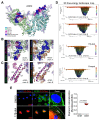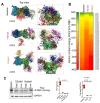Structural and Functional Analysis of Female Sex Hormones against SARS-CoV-2 Cell Entry
- PMID: 34768939
- PMCID: PMC8584232
- DOI: 10.3390/ijms222111508
Structural and Functional Analysis of Female Sex Hormones against SARS-CoV-2 Cell Entry
Abstract
Emerging evidence suggests that males are more susceptible to severe infection by the SARS-CoV-2 virus than females. A variety of mechanisms may underlie the observed gender-related disparities including differences in sex hormones. However, the precise mechanisms by which female sex hormones may provide protection against SARS-CoV-2 infectivity remains unknown. Here we report new insights into the molecular basis of the interactions between the SARS-CoV-2 spike (S) protein and the human ACE2 receptor. We further report that glycosylation of the ACE2 receptor enhances SARS-CoV-2 infectivity. Importantly, estrogens can disrupt glycan-glycan interactions and glycan-protein interactions between the human ACE2 and the SARS-CoV-2 thereby blocking its entry into cells. In a mouse model of COVID-19, estrogens reduced ACE2 glycosylation and thereby alveolar uptake of the SARS-CoV-2 spike protein. These results shed light on a putative mechanism whereby female sex hormones may provide protection from developing severe infection and could inform the development of future therapies against COVID-19.
Keywords: ACE2; COVID-19; estrogenes; sex hormones.
Conflict of interest statement
The authors declare no conflict of interest.
Figures





Update of
-
Structural and functional analysis of female sex hormones against SARS-Cov2 cell entry.bioRxiv [Preprint]. 2020 Jul 29:2020.07.29.227249. doi: 10.1101/2020.07.29.227249. bioRxiv. 2020. Update in: Int J Mol Sci. 2021 Oct 26;22(21):11508. doi: 10.3390/ijms222111508. PMID: 32766583 Free PMC article. Updated. Preprint.
References
-
- Glinsky G.V. Tripartite combination of candidate pandemic mitigation agents: Vitamin D, quercetin, and estradiol manifest properties of medicinal agents for targeted mitigation of the COVID-19 pandemic defined by genomics-guided tracing of SARS-CoV-2 targets in human cells. Biomedicines. 2020;8:129. - PMC - PubMed
-
- Sama I., Ravera A., Santema B.T., Van Goor H., Ter Maaten J.M., Cleland J.G.F., Rienstra M., Friedrich A.W., Samani N.J., Ng L.L., et al. Circulating plasma concentrations of angiotensin-converting enzyme 2 in men and women with heart failure and effects of renin–angiotensin–aldosterone inhibitors. Eur. Heart J. 2020;41:1810–1817. doi: 10.1093/eurheartj/ehaa373. - DOI - PMC - PubMed
MeSH terms
Substances
Grants and funding
LinkOut - more resources
Full Text Sources
Molecular Biology Databases
Miscellaneous

